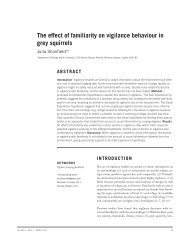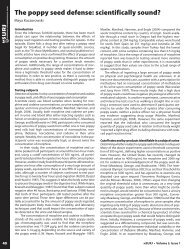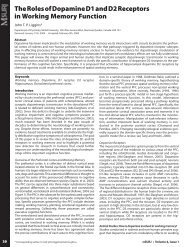the entire issue - McGill Science Undergraduate Research Journal ...
the entire issue - McGill Science Undergraduate Research Journal ...
the entire issue - McGill Science Undergraduate Research Journal ...
You also want an ePaper? Increase the reach of your titles
YUMPU automatically turns print PDFs into web optimized ePapers that Google loves.
Operational transformation in cooperative software systems<br />
Jupiter<br />
Jupiter, a multi-user remote collaboration virtual world developed at<br />
Xerox PARC by Nichols et al., addressed some of <strong>the</strong> <strong>issue</strong>s found in<br />
dOPT (7). One of <strong>the</strong> major changes in Jupiter was to have a centralized<br />
coordination server that uses a change propagation algorithm to<br />
keep <strong>the</strong> clients updated and in check.<br />
The optimistic concurrency techniques are used in <strong>the</strong> individual client-server<br />
links, where <strong>the</strong> synchronization algorithm in <strong>the</strong> individual<br />
client-server links is very similar to <strong>the</strong> dOPT algorithm.<br />
The major changes in Jupiter, in comparison with dOPT, is that instead<br />
of a transformation matrix, Jupiter uses a function called xform,<br />
which takes a pair of client and server operation requests, and transforms<br />
<strong>the</strong>m as a new pair of operations that lead <strong>the</strong> client and server<br />
operations to <strong>the</strong> same final state.<br />
The xform technique is successful while <strong>the</strong> client and server are in<br />
<strong>the</strong> same starting state, but if <strong>the</strong> client and server diverge too much,<br />
<strong>the</strong>n <strong>the</strong> operation must look back into its past history to properly<br />
calculate <strong>the</strong> converging operations. This is often done by keeping<br />
track of operation revision history, but not directly transforming<br />
saved messages, like dOPT does, which causes <strong>the</strong> incorrect scenario.<br />
Instead, Jupiter calculates past converging operations, even if it does<br />
not apply <strong>the</strong>m, in order to generate <strong>the</strong> correct recent transformed<br />
operation.<br />
Google Wave OT<br />
Google Wave OT, <strong>the</strong> algorithm behind Google Docs and <strong>the</strong> former<br />
Google Wave product, was a modification on top of <strong>the</strong> Jupiter algorithm<br />
(14). The main changes to <strong>the</strong> Jupiter control algorithm are<br />
mainly in <strong>the</strong> client/server communication protocol, as well as optimizing<br />
<strong>the</strong> transformation functions for batch updates.<br />
Instead of sending client operations to <strong>the</strong> server whenever new operations<br />
are requested, <strong>the</strong> Google Wave OT client must wait for a<br />
server response before sending any more operations. In <strong>the</strong> meantime,<br />
<strong>the</strong> operations are composed toge<strong>the</strong>r into a single buffer, and<br />
<strong>the</strong>n sent toge<strong>the</strong>r once <strong>the</strong> server has processed <strong>the</strong> last batch of<br />
operations and converged.<br />
This technique serves two major purposes. First, as <strong>the</strong> server acknowledges<br />
<strong>the</strong> client before any new operations proceed, <strong>the</strong> client<br />
is capable of predicting <strong>the</strong> operation path that <strong>the</strong> server will<br />
take, and thus always send operations to <strong>the</strong> server that are always<br />
on <strong>the</strong> path. This simplifies <strong>the</strong> server implementation significantly,<br />
as <strong>the</strong> server only needs to keep track of its own history. Instead of<br />
taking a quadratic O(h 2 ) space for history on every possible path, it<br />
only takes up a linear O(h 2 ) space on <strong>the</strong> server for history, where h is<br />
<strong>the</strong> number of previous operations (and possible causal operations)<br />
required to calculate <strong>the</strong> correct OT path.<br />
Finally, <strong>the</strong> transformation algorithm handles operations in streams,<br />
ra<strong>the</strong>r than as single discrete operations. These operation sequence<br />
streams are guaranteed to be in order, as well as linear, so <strong>the</strong> streaming<br />
transformations can be performed in linear time.<br />
ABT (TIPS)<br />
A more modern protocol for OT is based on <strong>the</strong> admissibility-based<br />
transformation (ABT) framework, which has been formally verified<br />
for correctness (8,10). TIPS, an implementation of ABT, builds on top<br />
of existing HTTP protocols, and also uses a centralized server.<br />
Clients in TIPS are able to join or leave a session at any time, and <strong>the</strong><br />
clients also independently decide to sync with <strong>the</strong> server. As with<br />
Google Wave OT, operations are buffered and synchronized with <strong>the</strong><br />
server only at some particular server-determined interval. This is<br />
useful, as it can be easily adapted to JavaScript-based long polling<br />
methods, which are <strong>the</strong> traditional method of maintaining an open<br />
connection over <strong>the</strong> web.<br />
Once <strong>the</strong> server has asked all of <strong>the</strong> clients to synchronize, each client<br />
that has responded will have <strong>the</strong>ir operations applied to an n-way<br />
merge algorithm, which will create a sequential set of operations as<br />
output. The clients receive this sequential set of operations in ano<strong>the</strong>r<br />
interval, which is adapted by <strong>the</strong>m through ano<strong>the</strong>r algorithm,<br />
ITSQ, which performs <strong>the</strong> inclusion transformation step that updates<br />
<strong>the</strong> document correctly.<br />
The benefit of TIPS over existing protocols is that it is more capable<br />
of allowing clients to dynamically enter and exit a particular OT session,<br />
as well as being more robust when dealing with client or network<br />
failures.<br />
Summary<br />
Operational transform is still a rapidly developing technology, with<br />
many particular algorithms and system implementations that are<br />
well-suited for particular tasks. These algorithms can differ in <strong>the</strong><br />
consistency guarantees <strong>the</strong>y support, as well as functionality, and <strong>the</strong><br />
most useful algorithm often depends on <strong>the</strong> specific application that<br />
is being built. Both <strong>the</strong> high-level design of <strong>the</strong> OT control algorithm,<br />
as well as <strong>the</strong> low-level design of <strong>the</strong> OT data and operation models is<br />
significant in determining which systems are <strong>the</strong> most practical.<br />
Real-time collaborative applications are slowly becoming some of <strong>the</strong><br />
more widely used applications in business environments, and with<br />
fur<strong>the</strong>r development with Internet-accessible mobile devices, <strong>the</strong>se<br />
applications will continue to flourish. Operational transformation<br />
will continue to be a significant research topic in <strong>the</strong> coming years as<br />
Volume 8 - Issue 1 - March 2013 67









